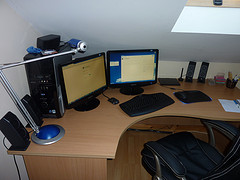Home office workers! In case you hadn’t heard about it, the IRS made some changes to the way the home office deduction works for 2013. Essentially, you are now allowed to deduct a flat $5 per square foot of dedicated office space, with a maximum of 300 square feet. But this new “safe harbor” option isn’t for everyone. Listed below are three reasons this may be good for you, and a couple of reasons that you might want to use the old method.
3 Reasons It’s a Good Thing
Depreciation recapture not needed any longer – if you are just starting out taking the home office deduction, you can forget about this concept of “depreciation recapture”. This is a required add-back (actually basis reduction) when you sell your home. If you took the old-style home office deduction, including depreciation of your home office space, you’ll still need to keep records of the depreciation that you claimed in earlier years and recapture that depreciation when you sell your home. (Note: you’ll also need to maintain these records even if you start taking the safe harbor amount, since you might switch back to the old method, as well. More on that later.)
Less record keeping – In the past when calculating the home office deduction, you needed to gather together your utility bills, mortgage interest, real estate taxes, repair bills, etc., in order to determine the amount that is attributable to the home office. Under the safe harbor rule, this isn’t necessary.
No loss of mortgage exp deduction – In addition to the above, under the old method, any amount for real estate taxes and mortgage interest that are claimed under the home office deduction had to be subtracted from those expenses for use on your Schedule A – this is no longer required if using the safe harbor $5 rule.
2 Reasons You May Want to Stick With the Old Rule
Office or dedicated space is larger than 300 square feet – You’re limited to 300 square feet under this new provision. For many home office deducters, this will be plenty, but there are likely many exceptions. If your office includes a dedicated waiting area, for example, this could easily go beyond the 300 square foot maximum.
Carry overs from prior years are lost/no carryover allowed – if your home office expenses are greater than your gross income less business expenses and you’re using the new safe harbor method, there is no carryover of the excess to future years. Using the old method, the excess could be carried over. In addition, if you switch to the safe harbor method, any prior year carryover is lost.
(Here’s a bonus, but it’s not for the faint of heart!) If you later switch to the old method you have to account for the prior depreciation (only as basis for depreciation). This over-complicates the depreciation calculation, as you must skip the years when depreciation isn’t charged to determine basis for the current year, but account for those years when determining which year’s depreciation to deduct.
General
Choice can be changed each year – Using the safe harbor rule in one year doesn’t lock you into that choice for the future. You can switch back & forth every year if you wish… but keep in mind that this is going to complicate your depreciation calculations quite a bit. Also, once you’ve filed a return with one choice or the other, you cannot go back and amend the return to change the method of home office deduction – it’s an irrevocable choice.
If you have more than one home and you intend to take the home office deduction for offices in each home, you are limited to using the safe harbor for only one of the offices in any particular year. You can still use the old method on your other home offices in that year. You’re not required to use the safe harbor rule for any of the offices.





 Sterling Raskie, MSFS, CFP®, ChFC®
Sterling Raskie, MSFS, CFP®, ChFC® The latest in our Owner’s Manual series, A 401(k) Owner’s Manual, was published in January 2020 and is available on
The latest in our Owner’s Manual series, A 401(k) Owner’s Manual, was published in January 2020 and is available on  A Medicare Owner’s Manual, is updated with 2020 facts and figures. This manual is available on
A Medicare Owner’s Manual, is updated with 2020 facts and figures. This manual is available on  Social Security for the Suddenly Single can be found on Amazon at
Social Security for the Suddenly Single can be found on Amazon at  Sterling’s first book, Lose Weight Save Money, can be
Sterling’s first book, Lose Weight Save Money, can be  An IRA Owner’s Manual, 2nd Edition is available for purchase on Amazon. Click the link to choose the
An IRA Owner’s Manual, 2nd Edition is available for purchase on Amazon. Click the link to choose the  Jim’s book – A Social Security Owner’s Manual, is now available on Amazon. Click this link for the
Jim’s book – A Social Security Owner’s Manual, is now available on Amazon. Click this link for the  And if you’ve come here to learn about queuing waterfowl, I apologize for the confusion. You may want to discuss your question with Lester, my loyal watchduck and self-proclaimed “advisor’s advisor”.
And if you’ve come here to learn about queuing waterfowl, I apologize for the confusion. You may want to discuss your question with Lester, my loyal watchduck and self-proclaimed “advisor’s advisor”.